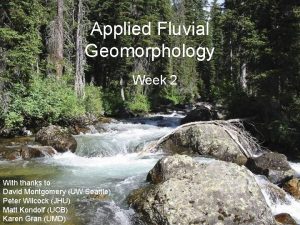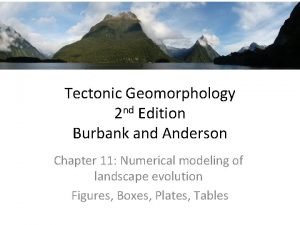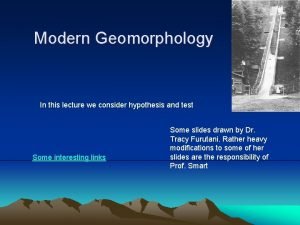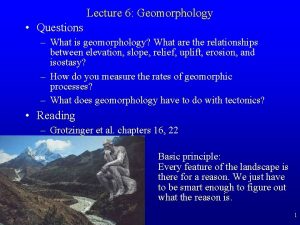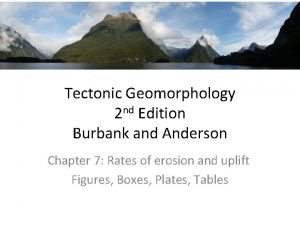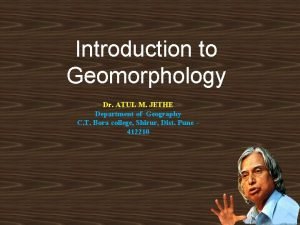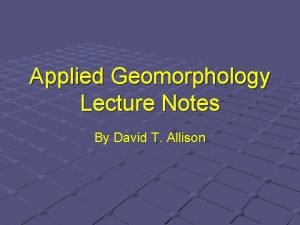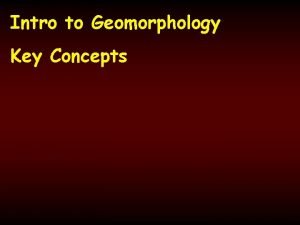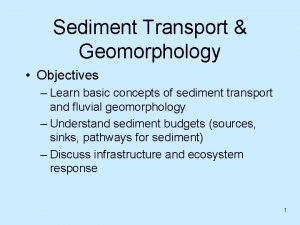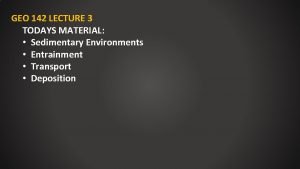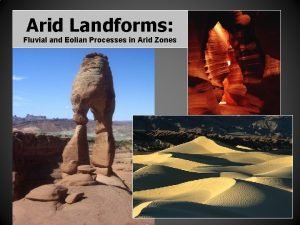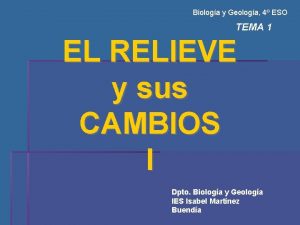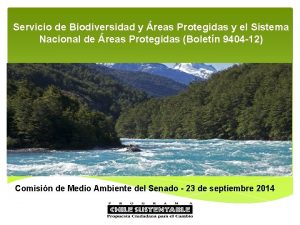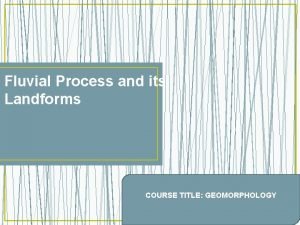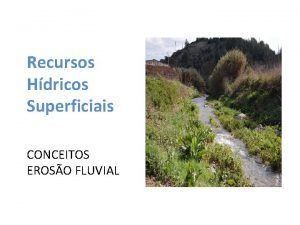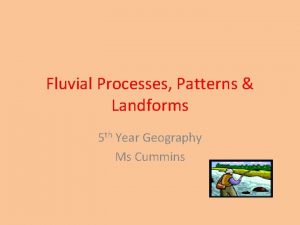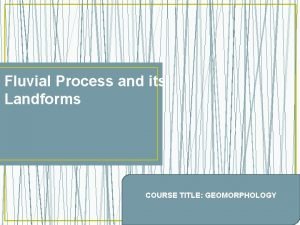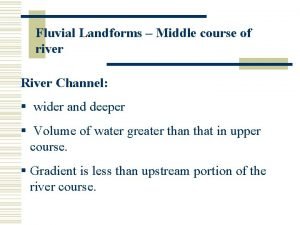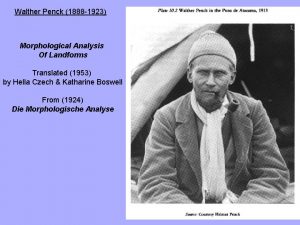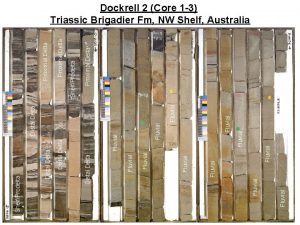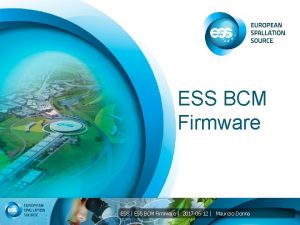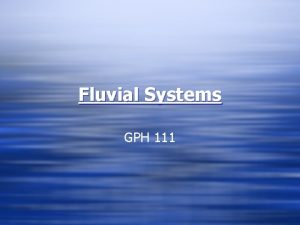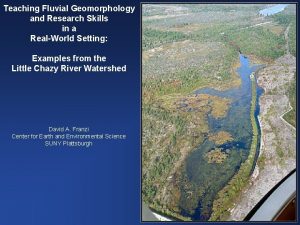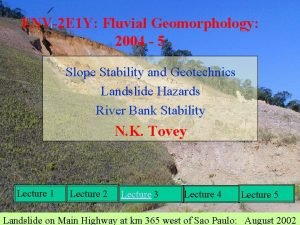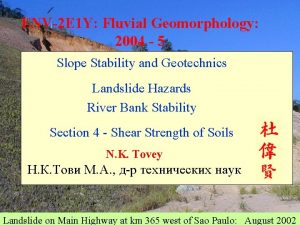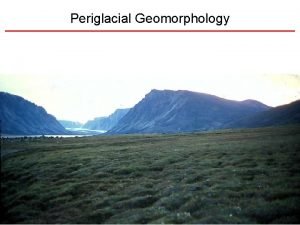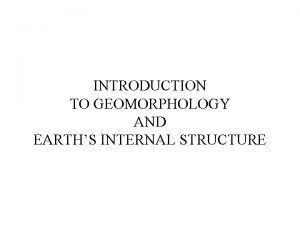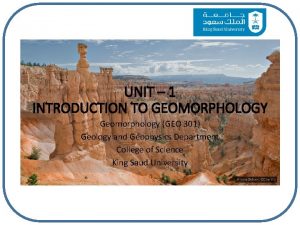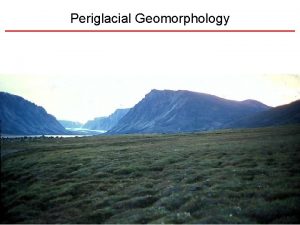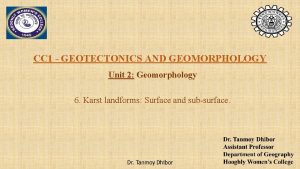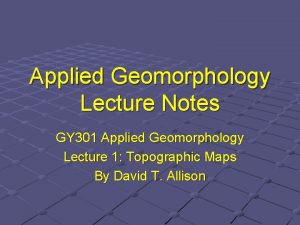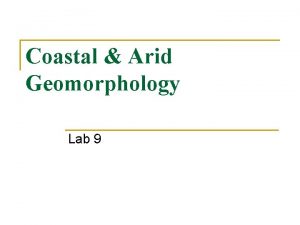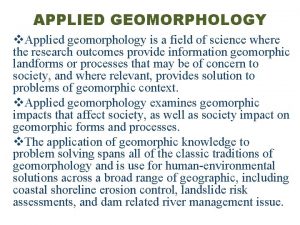Fluvial Geomorphology ESS 400 a Summer 2017 The
































































- Slides: 64

Fluvial Geomorphology ESS 400 a Summer 2017

The fluvial system Headwaters Straight channel Tributary Meandering channel Delta Wate r flow

Gravity! The engine for geomorphic work The fluvial system Headwaters Straight channel Tributary Meandering channel Delta Wate r flow

The fluvial system Gravity drives changes…. but the amount of water and sediment is controlled by basin size. Drainage basin (watershed): the area contributing water and sediment to the channel

The fluvial system The volume of water increases downstream as more tributaries and run-off join This volume of water is termed discharge, and is the volume of water flowing through a channel per time unit Therefore, Q = v * A So as Q increases, velocity and area increase Note: At the reach scale, such as Price Creek, Q is constant

Hydrology Q = area * velocity = width * depth * velocity

The fluvial system What do these streams look like? Straight channels:

The fluvial system What do these streams look like? Meandering channels:

The fluvial system What do these streams look like? Braided channels:

The fluvial system Pool-riffle features in meandering or sinuous rivers Pool: over-deepened channel segment from scour or high discharge events Riffle: shallow channel segment with rough low-flow water surface Bar: above flow, locus of sediment deposition during high flows Thalweg: German for valley. The deepest, and often fastest, part of the channel

The fluvial system Pool-riffle features in meandering or sinuous rivers

Meander migration 1. Cut banks erode 2. New sediment deposited on bar 3. Meander migrates 4. Planes off a valley

Incision • A stream’s ability to do geomorphic work is basically dictated by its basal shear stress: • Shear stress = depth * slope * gravity * water density • (Or, if you prefer, Stream power = discharge * slope * gravity * water density) • Shear stress can: • Transport sediment (finer sediment requiring less shear stress to move) • Incise into bedrock (often by abrasion from sediment being transported) • Be dissipated when water interacts with flow obstructions in the channel

Incision. Planation forms the valley, but how does a river erode down? Rivers are at a “graded equilibrium”, where their profiles approximate an inverse log curve A change to the shape of this curve – i. e. fault uplift – can provoke a reaction – such as incision and knickpoint formation

Fau lt Incision. Planation forms the valley, but how does a river erode down?

Fau lt Incision. Planation forms the valley, but how does a river erode down?

Incision. Planation forms the valley, but how does a river erode down? The river upstream of the fault is now going to erode down to return to its previous equilibrium, and there is now a knickpoint (zone of steepened slope) Knickpoint Fault

Incision. Planation forms the valley, but how does a river erode down? The steeper slope at the knickpoint will increase the erosion rate there Knickpoint will move upstream like a wave Migration style of knickpoint will depend on bedrock and substrate

Knickpoints There are multiple ways to generate a knickpoint, including: 1. Differential bedrock strength creating zones of different erosion 2. Base level drop from sea level changes or rock uplift 3. Base level drop from faulting across the river 4. Changes in discharge from stream capture, piracy, or beheading 5. Anthropogenic influences – redirecting streams, changing surrounding surfaces 6. Natural or artificial damming

Terraces Fill terraces Alluvium only, bedrock buried Strath terraces Erosion & planation into bedrock with thin gravel cap Paired terraces Un-paired terraces Incision and planation occur at different times Incision and planation occur together (more common)

Landforms Floodplain: the lowest surface adjacent to the river that is composed of overbank flood deposits overlying laterally accreted alluvium Point bar: sediment deposited on the inside of meander as meander expands Cut bank: steep bank on the outside of meander, developed as meander expands Terrace: abandoned floodplain, product of incision and lateral planation Oxbow: abandoned meander bend in the floodplain Alluvial fan (not shown): conical in shape, loose, coarse sediments from small channels on steep hillslopes

Response timescales • Terraces form due to incision, which we learned has multiple triggers • Thus, a younger terrace might record recent 103 year fault movement, while an older terrace might be due to climate variations on a 104 to 105 timescale

The Lane Balance

Response Timescales Terraces aren’t the only features left from the adjustment of rivers to environmental changes

Let’s dive into a survey… The basic idea: use the autolevel to create a flat plane, and measure how far down from that plane the topography is.

Teams of 3: Rod person Surveying 101 Level operator Note taker

Teams of 3: Rod person Tasks: 1. Responsible for the rod 2. Selects suitable measurement location! 3. Waves rod Ranges ahead foresights, stationary for backsight Surveying 101

Teams of 3: Level operator Tasks: 1. Responsible for autolevel 2. Sets up tripod and levels it 3. Sights Pretty stationary; pivots around rod-person during backsight Surveying 101

Teams of 3: Note taker Tasks: 1. Takes majority of notes 2. Records all measurements! 3. Plots measurements IN FIELD Moves between rod-person and level operator Surveying 101

Equipment: The stadia rod Basically, it’s a very tall metric ruler. Alternating yellow and white backgrounds indicate meters. Big numbers give decimeters. Big filled rectangles are centimeters. Small filled rectangles are 0. 5 centimeters. Surveying 101

Equipment: The tripod Autolevel base screws into the top of the tripod. Each leg swings out and its height can be adjusted using the black levers. Pointed legs secure tripod into ground. Surveying 101

Equipment: The autolevel Knobs adjust focus inside autolevel Sight in through here Autolevel rotates on swivel Base screws into top of tripod Surveying 101 See what is over here 3 toggles finetune leveling

Let’s dive into a survey… The basic idea: use the autolevel to create a flat plane, and measure how far down from that plane the topography is.

Step 1: General notes Weather, objectives, etc. Team names & roles Sketch map

Step 2: Making a measurement 1. “Wave” the rod to get the correct reading:

Step 2: Making a measurement 1. “Wave” the rod to get the correct reading Optional: Make 3 readings: upper stadia horizontal lower stadia Distance* = (upper stadia – lower stadia) x 100 *Can also use a tape to get distance

Step 3: Record measurement Record the measurements!

Where am I? Backsighting: measuring to a station of known elevation in order to get your current elevation. Station 1 Benchmark 100 meters

Station 1 Benchmark 100 meters BM 100 Concrete USGS benchmark 1. Record the elevation of the benchmark

2. 50 Station 1 Benchmark 100 meters BM 2. 50 100 Concrete USGS benchmark 2. Record the backsight reading

2. 50 Station 1 Benchmark 100 meters BM 2. 50 102. 5 100 Concrete USGS benchmark 3. Add the backsight to the elevation to get the height of instrument

Where is that? Foresight: Measuring to an unknown elevation from a known elevation. Station 1: 102. 5 m

BM 1. 1 2. 50 102. 5 100 Concrete USGS benchmark 1. Number your location (I prefer station # “. ” foresight #)

2. 90 BM 1. 1 2. 50 102. 5 2. 90 100 Concrete USGS benchmark 2. Record the foresight reading

2. 90 BM 1. 1 100 2. 50 102. 5 2. 90 99. 6 Concrete USGS benchmark 3. Subtract the foresight from height of instrument to get elevation

2. 90 BM 1. 1 Concrete USGS benchmark 100 2. 50 102. 5 2. 90 99. 6 20. 0 4. Record the distance (tape or stadia distance)

2. 90 BM 1. 1 Concrete USGS benchmark 100 2. 50 102. 5 2. 90 99. 6 20. 0 End of terrace tread, start of floodplain 5. Don’t forget to make notes about the station (water depth, etc. )

I can’t see the rod anymore! • Turning point: pivoting your autolevel around a known elevation point to get a better vantage ? ? ?

• Rod person holds the rod at the last foresight • Level operator moves to a new station • Backsight to the rod to get a new height of instrument

Turning point cont’d. BM 1. 1 TP 2. 1 Concrete USGS benchmark 100 2. 50 102. 5 2. 90 99. 6 2. 30 99. 6+2. 30 101. 9 (2. 91 -2. 89)*100 20. 0 End of terrace tread, start of floodplain Turning point New station, continuing survey

Don’t forget to close the loop! Why? • Checks for accuracy • Necessary if you’ve done a turning point After survey is complete, survey back to the original benchmark and compare this measured elevation with the actual elevation.

Note these! • Backsight (BS) + Elevation = Height of Instrument (HI) • HI – Foresight (FS) = Elevation Constantly calculate elevations in the field, and plot your transects in the field to catch any mistakes!

Price Creek

Price Creek

Price Creek

Tectonic geomorphology and structural evolution of Centennial Valley, MT: Exploring the linkage between subsurface structure, surface faulting, and landscape evolution in the wake of Yellowstone. Claudio Berti, Frank J. Pazzaglia, Pier Paolo Bruno Istituto Nazionale di Geofisica e Vulcanologia Founded by Lehigh University through the generosity of Mark and Kristen Koelmel and Chevron Corporation and University of Utah

Lima Reservoir Fault Centennial Valley Centennial Fault BLUE = location of the reflection seismic line shot this summer (August, 2012) RED = CF and LRF faults

Lim a Re serv oir F ault Ce Centennial seismic line nte nni a l. F aul t PC-29. 1 well Earthquake occurrence since 1973. Yellow circle 0. 3<M<4; Red circle: 4<M<5; (USGS Database)

Centennial seismic line South North

Centennial seismic line South North

Centennial seismic line South North

Centennial seismic line Centennial Fault South Red Rock River North

Centennial seismic line Centennial Fault South Red Rock River North

Centennial seismic line Centennial Fault South Red Rock River North
 Applied fluvial geomorphology
Applied fluvial geomorphology 200+400+600+800
200+400+600+800 Luther burbank middle school
Luther burbank middle school Hypothesis for geomorphology
Hypothesis for geomorphology Forces
Forces Tectonic
Tectonic Application of geomorphology
Application of geomorphology Applied geomorphology notes
Applied geomorphology notes Dynamic equilibrium in geomorphology
Dynamic equilibrium in geomorphology Lane's balance
Lane's balance Transport fluvial avantages inconvénients
Transport fluvial avantages inconvénients Alluvial vs fluvial
Alluvial vs fluvial Vale fluvial
Vale fluvial Modelado fluvial agente geologico
Modelado fluvial agente geologico Fluvial landforms
Fluvial landforms Modelado fluvial
Modelado fluvial Mapa fluvial de colombia
Mapa fluvial de colombia Procesos fluviotorrenciales
Procesos fluviotorrenciales Erosão
Erosão Curs calificare marinar fluvial
Curs calificare marinar fluvial Modelado fluvial
Modelado fluvial Fluvial process
Fluvial process Erosão fluvial
Erosão fluvial Landforms geography
Landforms geography Ollem turismo fluvial
Ollem turismo fluvial Modelado fluvial
Modelado fluvial What is a fluvial process
What is a fluvial process Fluvial
Fluvial Curiosidades de las torres de quart
Curiosidades de las torres de quart Los biomas fluviales
Los biomas fluviales Fluvial cycle of erosion by davis and penck
Fluvial cycle of erosion by davis and penck Flowarm pltw software
Flowarm pltw software Bổ thể
Bổ thể Biện pháp chống mỏi cơ
Biện pháp chống mỏi cơ Phản ứng thế ankan
Phản ứng thế ankan Thiếu nhi thế giới liên hoan
Thiếu nhi thế giới liên hoan Vẽ hình chiếu vuông góc của vật thể sau
Vẽ hình chiếu vuông góc của vật thể sau điện thế nghỉ
điện thế nghỉ Chúa yêu trần thế alleluia
Chúa yêu trần thế alleluia Một số thể thơ truyền thống
Một số thể thơ truyền thống Hệ hô hấp
Hệ hô hấp So nguyen to
So nguyen to Công thức tiính động năng
Công thức tiính động năng Tỉ lệ cơ thể trẻ em
Tỉ lệ cơ thể trẻ em đặc điểm cơ thể của người tối cổ
đặc điểm cơ thể của người tối cổ Các châu lục và đại dương trên thế giới
Các châu lục và đại dương trên thế giới ưu thế lai là gì
ưu thế lai là gì Thẻ vin
Thẻ vin Tư thế ngồi viết
Tư thế ngồi viết Các môn thể thao bắt đầu bằng từ đua
Các môn thể thao bắt đầu bằng từ đua Cái miệng bé xinh thế chỉ nói điều hay thôi
Cái miệng bé xinh thế chỉ nói điều hay thôi Hình ảnh bộ gõ cơ thể búng tay
Hình ảnh bộ gõ cơ thể búng tay Từ ngữ thể hiện lòng nhân hậu
Từ ngữ thể hiện lòng nhân hậu Tư thế ngồi viết
Tư thế ngồi viết Trời xanh đây là của chúng ta thể thơ
Trời xanh đây là của chúng ta thể thơ Voi kéo gỗ như thế nào
Voi kéo gỗ như thế nào Thế nào là giọng cùng tên? *
Thế nào là giọng cùng tên? * Thể thơ truyền thống
Thể thơ truyền thống Sự nuôi và dạy con của hươu
Sự nuôi và dạy con của hươu Thế nào là hệ số cao nhất
Thế nào là hệ số cao nhất đại từ thay thế
đại từ thay thế Diễn thế sinh thái là
Diễn thế sinh thái là Slidetodoc
Slidetodoc Vẽ hình chiếu vuông góc của vật thể sau
Vẽ hình chiếu vuông góc của vật thể sau Phép trừ bù
Phép trừ bù
